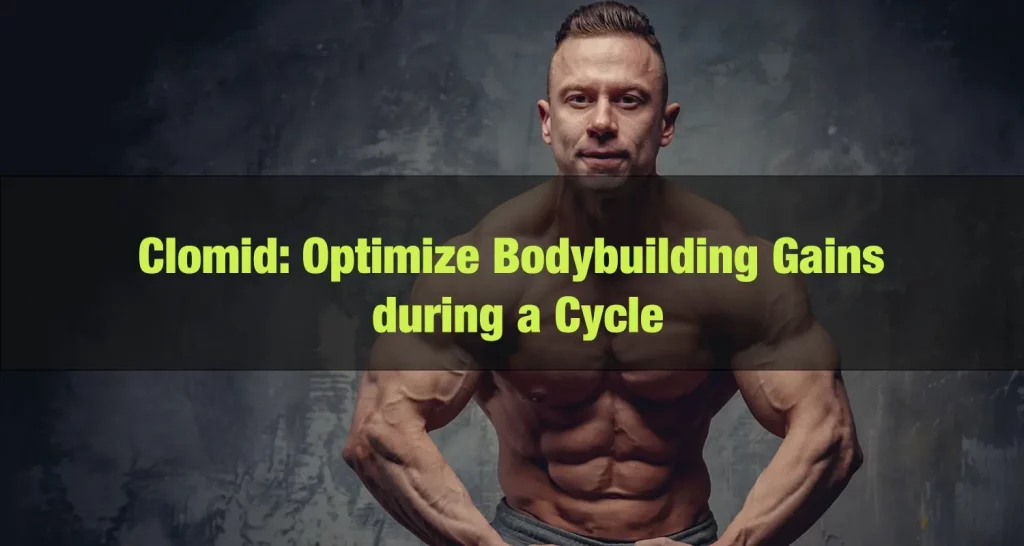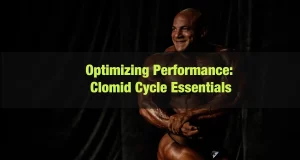Has your muscle-building journey hit a plateau despite intense workouts and proper nutrition? Maybe you’ve finished a steroid cycle and are struggling with the notorious post-cycle ‘crash’? If these scenarios sound familiar, you’re in the right place. In the bodybuilding universe, where gaining muscle and sustaining growth is paramount, many athletes are turning to an unconventional tool: Clomid. While Clomid, or Clomiphene Citrate, is traditionally used in the realm of fertility treatments, it’s being harnessed by bodybuilders worldwide to optimize their gains and overcome hormonal setbacks after steroid cycles.
In this comprehensive blog post, we’re about to explore the intriguing concept of a Clomid cycle in bodybuilding. We’ll delve into how Clomid potentially stimulates the production of natural testosterone, crucial for muscle growth and recovery, and how it can be strategically used to minimize the downsides of post-steroid cycle hormonal imbalances. We’ll also take a critical look at the possible risks and side effects of this off-label usage, emphasizing that knowledge is power – and safety – when it comes to supplementation. This eye-opening journey could be the missing piece you’ve been searching for in your bodybuilding puzzle, offering a fresh perspective on maximizing gains. Buckle up – it’s time to revolutionize your bodybuilding regimen.
Learn more about Anavar
The Science Behind Clomid: Maximizing Bodybuilding Gains
Clomiphene Citrate, commonly known as Clomid, is an oral medication initially designed as a fertility treatment. The drug’s mechanism is rooted in its ability to interfere with the feedback loop involving the pituitary gland and the ovaries in women, leading to increased secretion of Follicle Stimulating Hormone (FSH) and Luteinizing Hormone (LH). As a result, the ovaries produce more eggs, increasing fertility.
In bodybuilding, this physiological principle has been applied to optimize gains. Anabolic steroids, mimicking the action of testosterone, are often used to stimulate muscle growth and enhance performance. However, the body, in an attempt to maintain hormonal homeostasis, downregulates its natural testosterone production when external sources are present. Consequently, when a steroid cycle ends, the body is left with significantly low testosterone levels. This hormonal imbalance can lead to muscle loss, low energy levels, and a range of other side effects.
To counteract this, bodybuilders have turned to Clomid as a post-cycle therapy (PCT) strategy. Clomid’s action mechanism in men parallels its function in women. By blocking estrogen’s influence on the pituitary gland, Clomid causes a surge in the production of LH. LH then stimulates the Leydig cells in the testes, leading to increased testosterone production. This uptick in natural testosterone helps maintain the muscle mass gained during the steroid cycle and aids recovery, ensuring sufficient testosterone for the body’s needs, including repairing damaged muscle tissue after intense workouts.
Despite Clomid’s potential in bodybuilding, it’s crucial to underscore that it’s not an anabolic steroid, and it doesn’t directly cause muscle growth. It merely aids in restoring natural testosterone levels after a steroid cycle. Furthermore, Clomid is not without risks. Side effects can range from minor inconveniences like mood swings and visual disturbances to more serious health complications, although these are rare. Moreover, the use of Clomid in this context is considered off-label, and it’s not universally endorsed by the medical community.
Given the complexities involved and potential risks, decisions involving Clomid as part of a bodybuilding regimen should be made judiciously
Boost Testosterone Levels Naturally with Clomid

Clomid is an intriguing player in the field of male hormonal health. This medication, originally designed as a fertility aid for women, has found its way into the bodybuilding and athletic world due to its ability to stimulate natural testosterone production.
Testosterone is a pivotal hormone in the male body, responsible for muscle mass and strength, bone density, and body hair. Natural production of testosterone can decrease due to various factors such as aging, stress, or following anabolic steroid use. The repercussions of low testosterone can include muscle mass loss, fatigue, and decreased sexual drive.
The mechanism of Clomid involves a strategic interaction with the pituitary gland, which is a vital hub for controlling hormone production. Specifically, Clomid inhibits the action of estrogen on the pituitary. In response, the body amps up the production of Follicle Stimulating Hormone (FSH) and Luteinizing Hormone (LH). The latter hormone is crucial as it prompts the Leydig cells in the testes to ramp up testosterone production.
In the bodybuilding context, Clomid is often implemented as a component of Post Cycle Therapy (PCT). PCT is a regimen used by athletes to restore natural hormone balance after a cycle of anabolic steroids. By encouraging the body’s natural testosterone production, Clomid aids in preserving the muscle mass gains achieved during the steroid cycle and promotes overall recovery.
However, it’s essential to keep in mind that the use of Clomid in bodybuilding is considered off-label, and it does not come without potential risks. Some individuals may experience side effects such as mood changes, dizziness, or even visual disturbances in rare cases. Therefore, it’s crucial to thoroughly research and consider these factors before deciding to incorporate Clomid into a fitness regimen.
To conclude, Clomid presents an unconventional but potential method for naturally stimulating testosterone production. Yet, it’s critical to balance this potential benefit against the understanding of possible risks. The ultimate aim should always be to enhance health and performance without compromising overall well-being.
Unlocking the Potential: Clomid and Muscle Growth
When it comes to unlocking the potential for muscle growth, bodybuilders are constantly searching for strategies and supplements that can give them an edge. Clomid, a medication primarily used for fertility purposes, has emerged as an intriguing option in the realm of bodybuilding.
One of the primary mechanisms through which Clomid impacts muscle growth is its ability to modulate the hormonal environment in the body. By acting as a selective estrogen receptor modulator (SERM), Clomid blocks estrogen receptors in the hypothalamus, disrupting the negative feedback loop that estrogen typically exerts on the hypothalamic-pituitary-gonadal (HPG) axis.
By inhibiting this feedback loop, Clomid increases the production of luteinizing hormone (LH) and follicle-stimulating hormone (FSH) from the pituitary gland. The rise in LH levels stimulates the testes to produce more testosterone, a crucial hormone for muscle growth and protein synthesis.
Increased testosterone levels foster an environment conducive to muscle hypertrophy. Testosterone promotes protein synthesis, which is essential for repairing and building new muscle tissue. Additionally, testosterone enhances nitrogen retention, leading to improved muscle recovery and reduced muscle breakdown.
Moreover, Clomid’s impact on the hormonal balance can contribute to an anabolic state, where the body is primed for muscle growth. By blocking estrogen receptors, Clomid helps minimize the conversion of testosterone into estrogen, a process known as aromatization. This reduction in estrogen levels can prevent the negative effects associated with high estrogen, such as water retention and fat gain, further optimizing the muscle-building process.
Optimizing Performance: Clomid Cycle Essentials
Clomid, an intriguing addition to the world of bodybuilding, has emerged as a useful tool in optimizing physical performance, particularly in the context of post-anabolic steroid cycles. Originating as a fertility medication, Clomid’s unique potential in stimulating natural testosterone production has carved out its place in bodybuilding.
One of Clomid’s essential benefits is its role in preserving muscle mass. After an intense regimen of anabolic steroids, a drop in the body’s natural testosterone levels is common, posing a challenge to maintaining hard-earned muscle gains. By stimulating the body’s testosterone production, Clomid serves to safeguard and uphold the muscle mass acquired during the steroid cycle.
Further, Clomid contributes significantly to overall body recovery. Post-strenuous workouts or a taxing steroid cycle, the body needs time to recover and regain hormonal balance. Here, Clomid steps in, enhancing the body’s natural testosterone production, thereby aiding recovery. This action ensures that adequate testosterone is available for various body functions, including the crucial process of repairing and rebuilding muscle tissues after intense workouts.
Clomid also offers an advantage for those transitioning away from anabolic steroids. Given its role in stimulating the body’s own testosterone production, Clomid provides a more natural alternative for bodybuilding and performance enhancement. This benefit can be a significant draw for those who aim to distance themselves from steroid use while still chasing their physique and performance goals.
Lastly, the Clomid cycle can be personalized to individual needs and responses. The flexibility in adjusting the dosage and duration of Clomid use allows bodybuilders to tailor their Clomid cycle, optimizing its benefits in line with their specific objectives.
To sum up, Clomid, with its distinctive potential benefits, presents an exciting option for bodybuilders seeking to optimize their performance and gains. Its roles in muscle mass preservation and recovery support. Understanding how to incorporate Clomid into a bodybuilding routine effectively is crucial in harnessing its benefits for superior results.
The Perfect Dosage: Finding Clomid’s Sweet Spot
Finding the optimal dosage, or “sweet spot,” for Clomid usage in bodybuilding can be a process of personal exploration and adaptation. As Clomid’s purpose in bodybuilding is primarily for Post Cycle Therapy (PCT) after an anabolic steroid cycle, the dosage will depend on factors such as the length and intensity of the steroid cycle, as well as individual physiological responses.
Traditionally, a Clomid cycle begins with a higher dosage and then tapers down. This approach creates an initial surge in testosterone levels, followed by a more gradual release. It is not uncommon for bodybuilders to start with 50-100mg per day in the first week or so of the PCT, then reduce the dosage to around 25-50mg per day for the remaining period. The entire Clomid cycle usually lasts about four to six weeks.
However, these numbers are not set in stone and will depend on your unique needs and response. The goal is to find the dosage that effectively restores your testosterone levels without inducing unwanted side effects. It’s also crucial to remember that more isn’t always better. High doses of Clomid can lead to the body adjusting to the high level of testosterone, which can eventually lower the efficacy of Clomid.
One approach to finding your sweet spot could be to start with the lower end of the dosage spectrum and monitor your response. Pay attention to how your body feels and how well you’re maintaining your muscle gains. If you’re not seeing the results you want, you can gradually increase the dosage until you find what works best for you.
Another essential factor to consider is the timing of your Clomid cycle. Ideally, you should start your Clomid cycle right after your steroid cycle ends. This timing ensures that Clomid can start working to restore your testosterone levels as soon as possible, which can help you retain your muscle mass and support recovery.
In conclusion, finding the perfect dosage for your Clomid cycle is a personalized process that requires attentiveness to your body’s response. Whether you’re aiming to preserve muscle mass, support recovery, or transition away from anabolic steroids, Clomid can be an effective tool when used at the right dosage and timing. Remember, the ultimate goal is not just about hitting the numbers but achieving optimal performance and overall wellbeing.
Overcoming Plateaus: Clomid as a Performance Enhancer
Plateaus can be one of the most frustrating experiences for bodybuilders and athletes. You push harder and harder, yet your progress seems to stall. However, Clomid presents a unique strategy to overcome these plateaus and optimize performance, particularly in the realm of post-anabolic steroid cycles.
Often, a plateau in bodybuilding can be tied to hormonal imbalances, particularly a decline in testosterone levels. This decline can be a result of rigorous training, aging, or following an anabolic steroid cycle, where the body’s natural testosterone production is suppressed. As testosterone plays a pivotal role in muscle growth and strength, a decline in its levels can result in stalled progress or even regression.
This is where Clomid steps in as a performance enhancer. Its primary function is to stimulate natural testosterone production. By boosting testosterone levels, Clomid can reinvigorate the body’s muscle-building capacity, potentially breaking through the frustrating plateaus. With restored testosterone levels, the body can effectively engage in protein synthesis, a key process in muscle growth and repair, thereby rejuvenating the bodybuilding progress.
Beyond muscle growth, Clomid can also enhance overall body performance. Testosterone influences various aspects of physical performance, including energy levels, stamina, and recovery rate. Therefore, by promoting testosterone production, Clomid may indirectly contribute to a surge in energy, improved endurance, and a faster recovery, all of which can be instrumental in overcoming performance plateaus.
Clomid also offers a potential advantage for those seeking a transition from anabolic steroids. Incorporating Clomid into the regimen allows bodybuilders to maintain their performance levels and muscle gains while their bodies restore natural testosterone production. This capability can be particularly beneficial for those who want to step away from anabolic steroid use but are concerned about losing their progress.
Clomid vs. Traditional Bodybuilding Supplements: A Comparative Analysis
When exploring the world of bodybuilding supplements, Clomid, or Clomiphene Citrate, stands out due to its distinct role and benefits, especially when compared to traditional bodybuilding supplements like protein powders, creatine, and branched-chain amino acids (BCAAs). While both Clomid and traditional supplements can support muscle growth and recovery, they work in different ways and serve different purposes within a bodybuilding regimen.
Traditional bodybuilding supplements are designed to directly support muscle growth and recovery. For instance, protein powders provide the body with essential amino acids necessary for muscle protein synthesis, the process by which the body builds new muscle tissue. Creatine supports the body’s production of ATP, the primary energy source for heavy lifting and high-intensity exercise. BCAAs, on the other hand, can promote muscle recovery and reduce exercise-induced muscle soreness.
In contrast, Clomid does not directly contribute to muscle growth or recovery. Instead, it supports the body’s natural production of testosterone, a hormone that plays a crucial role in muscle growth, strength, and recovery. After a cycle of anabolic steroids, testosterone production is usually suppressed, which can lead to muscle loss and a decrease in performance. Clomid works by stimulating the pituitary gland to produce more of the hormones that trigger testosterone production in the testes, thereby helping to maintain muscle gains and support overall recovery.
While Clomid and traditional bodybuilding supplements have different roles, they can potentially complement each other in a bodybuilding regimen. Traditional supplements provide direct support for muscle growth and recovery, while Clomid helps to maintain a favorable hormonal environment for muscle growth by promoting natural testosterone production.
Potential Side Effects of Clomid in Bodybuilding: What You Should Know
As with any supplement or drug, Clomid comes with potential side effects that individuals should be aware of before incorporating it into their bodybuilding routine. These side effects range from minor discomforts to more severe symptoms, each varying in occurrence and intensity from person to person.
One of the most common side effects reported by users of Clomid is mood swings. The change in hormonal balance induced by Clomid can impact mood and emotional well-being, leading to symptoms like irritability, anxiety, or depression in some individuals. While not everyone experiences these effects, being aware of this potential change is crucial, especially for those prone to mood disorders.
Another relatively common side effect is gastrointestinal discomfort. Some users report experiencing nausea, bloating, or stomach cramps. Although typically mild and temporary, these symptoms can be uncomfortable and may impact the individual’s daily activities or workout performance.
In addition, Clomid may also cause visual disturbances, such as blurred vision or seeing floaters. These side effects are generally rare but can be significant if they occur. Users experiencing any changes in vision should be aware that these could be linked to Clomid use.
Other reported side effects include hot flashes, dizziness, and headaches. While typically mild, these symptoms can be bothersome, especially if they persist or intensify over time. It’s important to note that these side effects usually subside once the body adjusts to Clomid or when usage is discontinued.
A unique aspect of Clomid usage is the potential for a significant rise in testosterone levels. While this is the intended effect, an overly high level of testosterone can potentially lead to symptoms of testosterone overload, such as acne, hair loss, or even aggression. These symptoms tend to occur if the Clomid dosage is excessively high or if usage is prolonged without proper cycling.
Taking Clomid to the Next Level: Advanced Strategies for Bodybuilders
Once a bodybuilder has mastered the basics of Clomid use, they may start looking for ways to take their Clomid usage to the next level. Advanced strategies can offer ways to optimize the benefits of Clomid and further enhance bodybuilding performance and gains.
One of the advanced strategies that bodybuilders can consider is pairing Clomid with other Post Cycle Therapy (PCT) agents. Although Clomid is effective in stimulating natural testosterone production, combining it with other PCT drugs like hCG or Nolvadex can further expedite the recovery of the body’s hormonal balance. This combination therapy can also help to address broader aspects of post-steroid-cycle recovery, providing a more comprehensive approach to PCT.
Another strategy is to integrate Clomid into a periodized training and supplementation plan. Instead of using Clomid only after an anabolic steroid cycle, consider scheduling your Clomid cycles in conjunction with your training cycles. This approach allows you to align the surge in testosterone levels with your most intense training phases, potentially maximizing your performance and gains during these periods.
Tuning in to the body’s response to Clomid is also a crucial advanced strategy. Over time, you may notice patterns in how your body reacts to different Clomid dosages or how it performs during a Clomid cycle. This insight can guide you in refining your Clomid regimen, whether it’s adjusting the dosage, altering the cycle duration, or changing the timing of your Clomid use relative to your training cycles.
Lastly, some bodybuilders may explore the use of Clomid as an alternative to anabolic steroids, rather than just a post-steroid-cycle supplement. Given its ability to stimulate natural testosterone production, Clomid could potentially serve as a more natural route to enhancing performance and physique. This strategy, however, requires careful planning and execution, as the effects of Clomid are more subtle and gradual compared to anabolic steroids.
Conclusion
In the landscape of bodybuilding and performance enhancement, Clomid presents a unique and compelling tool. By stimulating natural testosterone production, it offers a multitude of benefits, from preserving muscle mass to aiding recovery and serving as a potential alternative to anabolic steroids. Yet, like any powerful tool, Clomid usage should be approached thoughtfully and responsibly. This includes being aware of its potential side effects and understanding how to find the ideal dosage for your individual needs. Taking Clomid usage to the next level with advanced strategies can further optimize its benefits, allowing you to squeeze more out of each Clomid cycle. Ultimately, the goal is not just about maximizing gains, but also achieving a balance that promotes sustainable progress and overall well-being. As the world of bodybuilding continues to evolve, so too will the strategies and tools that we employ, with Clomid standing as a promising contributor in this dynamic journey.



